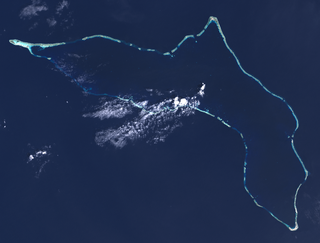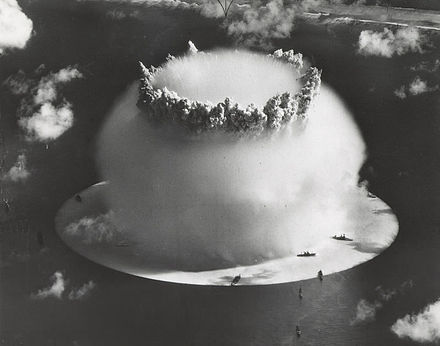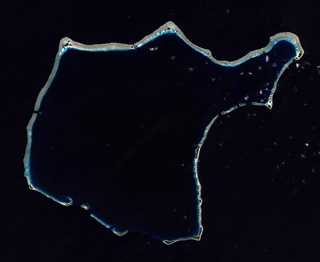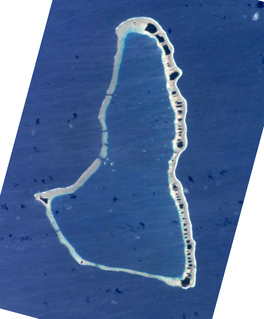
Micronesians settled the Marshall Islands in the 2nd millennium BC, but there are no historical or oral records of that period. Over time, the Marshall Island people learned to navigate over long ocean distances by canoe using traditional stick charts.

Kwajalein Atoll is part of the Republic of the Marshall Islands (RMI). The southernmost and largest island in the atoll is named Kwajalein Island, which its majority English-speaking residents often called by the shortened name, Kwaj. The total land area of the atoll amounts to just over 6 square miles (16 km2). It lies in the Ralik Chain, 2,100 nautical miles (3900 km) southwest of Honolulu, Hawaii.

Bikini Atoll is an atoll in the Marshall Islands that was the site of 23 nuclear tests during the 1940s and 1950s. The atoll consists of 23 islands totalling 3.4 square miles (8.8 km2) surrounding a 229.4-square-mile (594.1 km2) central lagoon. It is at the northern end of the Ralik Chain, approximately 87 kilometres (54 mi) northwest of Ailinginae Atoll and 850 kilometres (530 mi) northwest of Majuro. Within Bikini Atoll, Bikini, Eneu, Namu and Enidrik islands comprise just over 70% of the land area. Bikini and Eneu are the only islands of the atoll that hosted a permanent population. Bikini Island is the northeastern most and largest islet. The atoll was also known as Eschscholtz Atoll, after German naturalist Johann Friedrich von Eschscholtz, until 1946, after the Marshall Islands were captured by the U.S. during World War II.

Enewetak Atoll is a large coral atoll of 40 islands in the Pacific Ocean and with its 664 people forms a legislative district of the Ralik Chain of the Marshall Islands. With a land area total less than 5.85 square kilometres (2.26 sq mi), it is no higher than 5 meters and surrounds a deep central lagoon, 80 kilometres (50 mi) in circumference. It is the second-westernmost atoll of the Ralik Chain and is 305 kilometres (190 mi) west from Bikini Atoll.

Ebeye is the most populous island of Kwajalein Atoll in the Marshall Islands, as well as the center for Marshallese culture in the Ralik Chain of the archipelago. Settled on 80 acres of land, it has a population of more than 1500. Over 50% of the population is estimated to be under the age of 18.
The Compact of Free Association (COFA) is an international agreement establishing and governing the relationships of free association between the United States and the three Pacific Island nations of the Federated States of Micronesia, the Marshall Islands, and Palau. These nations, together with the Commonwealth of the Northern Mariana Islands, formerly composed the Trust Territory of the Pacific Islands, a United Nations trusteeship administered by the United States Navy from 1947 to 1951 and by the U.S. Department of the Interior from 1951 to 1986.

Rongerik Atoll or Rongdrik Atoll is a coral atoll of 17 islands in the Pacific Ocean, and is located in the Ralik Chain of the Marshall Islands, approximately 200 kilometres (120 mi) east of Bikini Atoll. Its total land area is only 1.68 square kilometres (0.65 sq mi), but it encloses a lagoon of 144 square kilometres (56 sq mi).

Kili Island or Kili Atoll is a small, 81 hectares island located in the Marshall Islands in the Pacific Ocean. It is the temporary home of 548 inhabitants who are descended from islanders who originally lived on Bikini Atoll. They were relocated when they agreed to let the U.S. government temporarily use their home for nuclear testing in 1945. Kili Island became their home after two prior relocations failed. The island does not have a natural lagoon and cannot produce enough food to enable the islanders to be self-sufficient. It is part of the legislative district of the Ralik Chain of the Marshall Islands. The island is approximately 48 kilometers (30 mi) southwest of Jaluit. It is one of the smallest islands in the Marshall Islands.

Ailinginae Atoll is an uninhabited coral atoll of 25 islands in the Pacific Ocean, on the northern end of the Ralik Chain of the Marshall Islands. Its total land area is only 2.8 square kilometres (1.1 sq mi), but it encloses a lagoon of 105.96 square kilometres (40.91 sq mi). It is located approximately 13 kilometres (8.1 mi) west of Rongelap Atoll. The landscape is low-lying with only the top 3 metres above sea level. The two entrances into the lagoon are 'Mogiri Pass' and 'Eniibukku Pass'. These are 0.9 and 0.3 miles wide respectively.

The Pacific Proving Grounds was the name given by the United States government to a number of sites in the Marshall Islands and a few other sites in the Pacific Ocean at which it conducted nuclear testing between 1946 and 1962. The U.S. tested a nuclear weapon on Bikini Atoll on June 30, 1946. This was followed by Baker on July 24, 1946.
The Marshallese culture is marked by pre-Western contact and the impact of that contact on its people afterward. The Marshall Islands were relatively isolated. Inhabitants developed skilled navigators, able to navigate by the currents to other atolls. Prior to close contact with Westerners, children went naked and men and women were topless, wearing only skirts made of mats of native materials.

Marshall Islands – United States relations are bilateral relations between Marshall Islands and the United States.
James Matayoshi is the mayor of Rongelap Atoll in the Marshall Islands. He was appointed as Rongelap's mayor in 1995 and has served as chairman of the Marshall Islands Ports Authority since 2008. As the mayor of Rongelap, Matayoshi was noted for his activism on calling for the United States government to render assistance to Marshall Islanders suffering from radiation sickness as a result of a series of nuclear tests carried out under Operation Castle in the 1950s.

The nuclear testing at Bikini Atoll program was a series of 23 nuclear devices detonated by the United States between 1946 and 1958 at seven test sites on the reef itself, on the sea, in the air and underwater. The test weapons produced a combined fission yield of 42.2 Mt of explosive power.

Kenneth Kedi is a Marshallese politician. He has been Speaker of the Legislature of the Marshall Islands since 4 January 2016. Kedi won the election with 19 votes to 14 of former Marshall Islands President Christopher Loeak. He succeeded Donald Capelle. Kedi is a member of the Kien Eo Ad (KEA) party.

India–Marshall Islands relations refers to bilateral relations between India and the Marshall Islands. The respective embassies of the two countries in Tokyo, Japan are concurrently accredited to each other. Marshall Islands maintains an Honorary Consulate in New Delhi.
Amenta Matthew is a Marshallese politician. She has been a member of the Legislature of the Marshall Islands since 2015, representing the electorate of Utrik. She has been the Minister of Internal Affairs in the government of Hilda Heine since February 2016. She previously represented the same electorate from 2007 to 2011, and was Minister of Health under Presidents Litokwa Tomeing and Jurelang Zedkaia from 2008 to 2011. She is the second woman in the Marshall Islands to serve as a government minister.




















